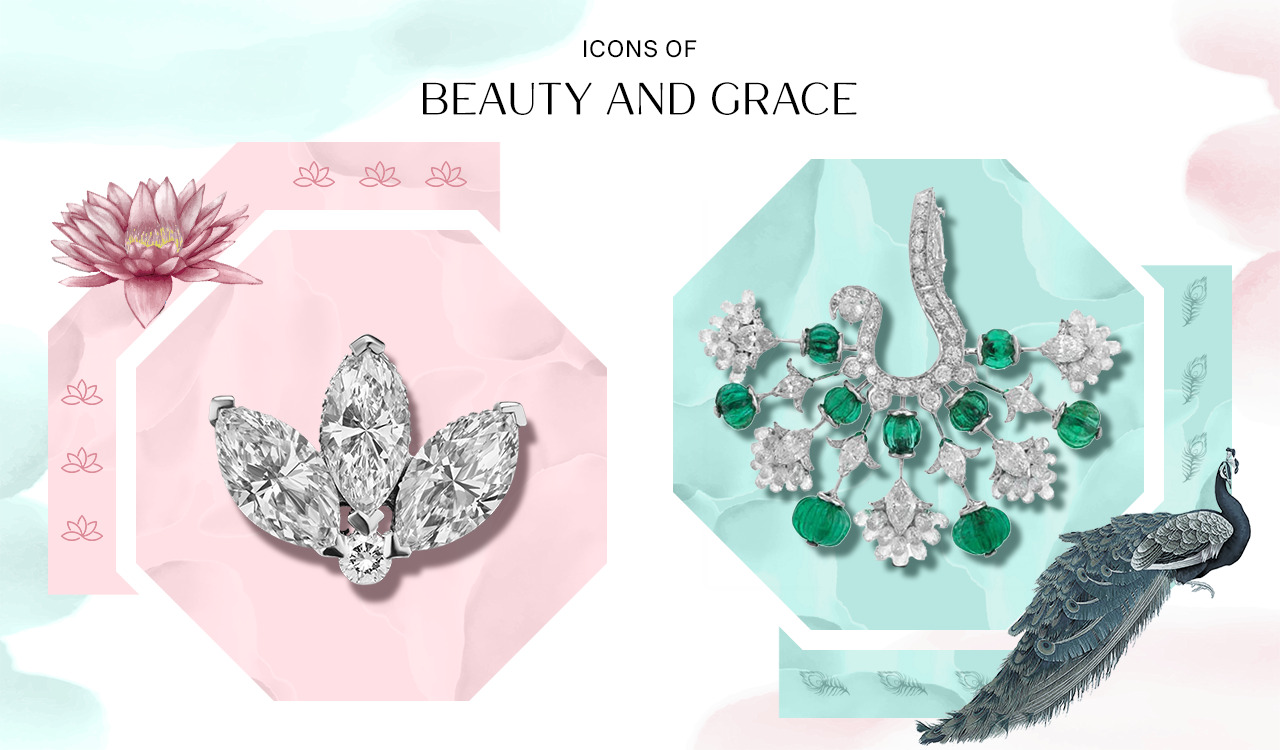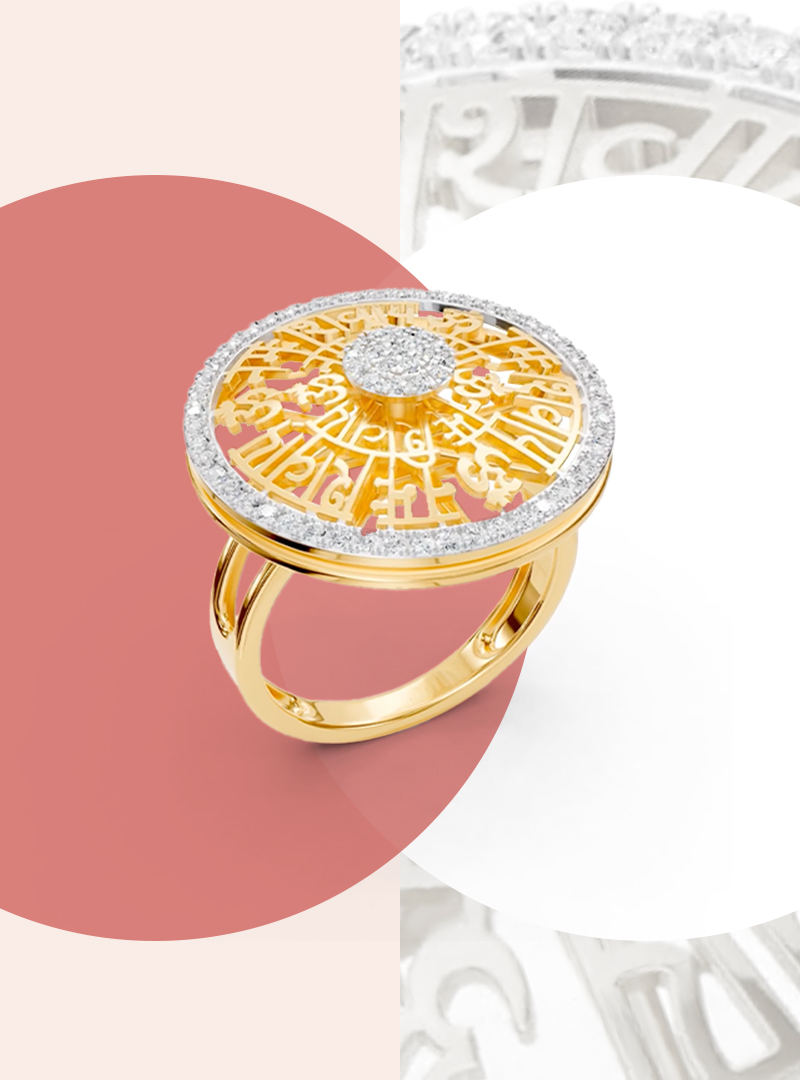From Adorning Nature to Natural Diamond Jewellery – The Journey of Indian Motifs
Fluid in form and flush with symbolism, India’s national bird and flower remain two of its most recognisable motifs, gifting the world enduring muses for high natural diamond jewellery.

India’s cultural heritage shines through in distinctive patterns/icons that have shaped global design vocabularies. Whether it’s the pipal patra (banyan leaf), champa (jasmine), or fishes and serpents, these motifs are mythological and cultural storytellers. Some, like the kirtimukha (lion face) and gandabherunda (a two-headed warrior bird) are rare and mysterious. Others are universally recognised.

On cue, two stunners emerge – India’s national bird – the vain, flamboyant peacock, and national flower – the pristine, unsullied lotus. Both have mythological origins, are associated with specific deities, and signify divine qualities that human beings should aspire to. From appearing on the 5th-century rock carvings to adorning sculptures, architecture and textiles, these motifs have indelibly stamped the country’s rich artistic identity. It’s little wonder that they’ve inspired jewellers to showcase another luxurious natural wonder – natural diamonds.
Poetry In Bloom
Delicately suspended over murky waters, the lotus denotes liberation from the material world while living in it. Popular across Southeast Asia, it is associated with Indian deities Brahma, Vishnu and Lakshmi. Popularly used in architecture, it has featured in the frescoes of 7th century Ellora caves, royal courts of Rajasthan and Himachal Pradesh, dotting the Taj Mahal’s chatttris / guldastas and forming the ‘seat’ of the national emblem.
Given its beauty, artisan jewellers couldn’t possibly resist this enchanting flower. After first adopting the motif in 1906, French luxury house Van Cleef & Arpels was smitten, returning to the lotus in multiple collections, including its latest, Diamond Breeze. The Maison’s signature Perle de rosée technique let’s light reflect through each natural diamond, accentuating their individual brilliance. But the lyrical movement – where the delicate natural diamond petals open out gracefully – is truly magical.


Padma-Perfect
In 2019, Lakshikaa Jewel’s Prince Bhandari created a ring that was inspired by the beauty and architecture of Delhi’s iconic Lotus Temple. It went on to win a Guinness World Record for the most number of natural diamonds used in a ring.
The designer drew from the spiritual symbolism of the Padma (lotus) using exactly 7,777 natural diamonds, a ‘lucky’ number.
While it’s unlikely that you’ll sport a multi-million dollar ring, the basic lotus motif is versatile, and thus easily adaptable to a modern woman’s daily wardrobe. It takes just three petals – the natural replica of a diamond marquise shape – to signify a blooming lotus, whether in the form of chic studs, a delicate pendant or a bracelet.
Let The Glory Unfurl
A mere flutter of the peacock’s ethereal plumage is enough to spark the arrival of spring in a billion hearts. The strutting bird has symbolized confidence, vanity and immortality since Babylonian times. It was associated with the Greek goddess Hera (Juno) who placed a hundred ‘eyes’ on the plumage, representing those of her guard Argus. In Indian mythology, a peacock called Citramekhala preened beside Saraswati, the Goddess of wisdom and learning. A Mor Pankh (peacock feather) was always tucked into the crown of Krishna, who – incidentally – was also known as Kamalasana, ‘the one who sits on a lotus throne’.
The union of two of Nature’s most sumptuous creations – peacocks and natural diamonds – is every maximalist’s fantasy. The bird’s ‘train’ – a biomechanical phenomenon that has fascinated physicists from the time of Isaac Newton – presents the jewellery craftsmen with a challenge. In Graff’s archival diamond Peacock Brooch – one of the most valuable contemporary jewels in the world – the peacock’s upper-tail coverts are depicted using tiers of marquise and pear-shaped multicoloured diamonds, where each ‘feather’ is adorned by white natural diamonds for a fluttery appearance. Milan based Buccellati’s signature rigato technique, which scores ultra-fine parallel lines in gold to mimic a lace-like texture punctuated by natural diamonds, is used in one of its many peacock brooches to craft an ethereal ‘fan’.

The peacock motif is arguably more expressive than the chaste lotus.
“Whenever I need to lift my spirits, all I have to do is to think of a peacock in full bloom.”
designer Harakh Mehta exults.
“It is a manifestation of the power of integrity and honesty, and the beauty we can achieve from within when we show our true colours.” For global designers, the motif is an extension of India, with its colour and drama. In his 2018 Peacock Dance collection, Italian designer Alessio Boschi was inspired by the bird’s “inherent iridescence and vivid tones” and chose to interpret them in the art and architecture of its natural habitat – India.

Peacock Jewel Investments – Preen A Bit, Shimmy A Little
The pompous peacock doesn’t stand on the sidelines. Natural diamond peacock brooches are must-have investment pieces for both men and women. They’re showstoppers, whether pinned on a bandhgala/sherwani, heritage sarees or a tailored blazer over denims and a white tee.
For further indulgence, one can invest in a red-carpet-worthy bracelet/bangle or a cocktail ring with peacocks mounted on a grand scale, invoking the splendour of the 17th Century Peacock Throne in the Red Fort’s Diwan-i-Khaas, encrusted with the famous Kohinoor Diamond amongst other jewels. A necklace/collier with the bird’s multi-eyed tail swerving dramatically around your neck is the ideal accessory for plunging necklines and off-the-shoulder gowns. The motif translates just as easily to minimalist jewels; natural diamond studs outlining the pear shape of the peacock’s curvaceous body or a chic watch with a natural diamond ‘tail’ neatly fanned out inside its dial.
The lotus and the peacock are India’s most enduring design ambassadors from amongst her 17 official national icons. They narrate her multifaceted mythological, cultural and artistic legacy while gliding and prancing into global works of art, including your dazzling traditional diamond jewellery. Their popularity owes as much to alluring physical form – challenges posed to designers and artisans – as it does to the universal emotions and values they evoke; inspiring mortal beings to strive for divine purity, integrity, confidence and regeneration. With every natural diamond-encrusted petal and every dazzling plumage, you carry a piece of India with you, a homage of meticulous craftsmanship to the beauty and spiritual essence of a mighty nation.
